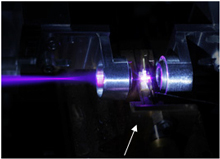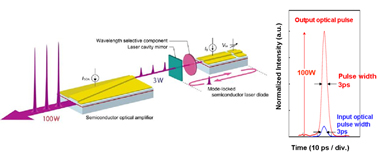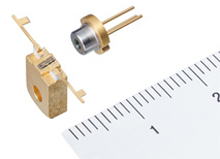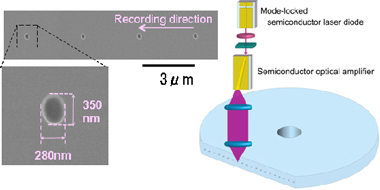
| Home | About Us | Contribute | Bookstore | Advertising | Subscribe for Free NOW! |
| News Archive | Features | Events | Recruitment | Directory |
News
20 July 2010
Tohoku and Sony develop first 100W blue-violet ultra-fast pulsed semiconductor laser
Professor Hiroyuki Yokoyama of Tohoku University’s New Industry Creation Hatchery Center (NICHe) and Sony Corp’s Advanced Materials Laboratories in Japan have jointly developed a blue-violet indium gallium nitride (InGaN)-based ultra-fast pulsed semiconductor laser with peak output that is 100 times that of the highest output for existing conventional blue-violet pulse semiconductor lasers (Appl. Phys. Lett. vol 97, issue 2, 021101).
 Figure 1. Beam emitted by blue-violet ultra-fast pulsed laser (arrow indicates SOA).
Figure 1. Beam emitted by blue-violet ultra-fast pulsed laser (arrow indicates SOA).
The new all-semiconductor-laser picosecond pulse light source has an emission wavelength of 405nm (in the blue-violet region of the spectrum), and can generate ultra-fast single-transverse-mode optical pulses as short as 3ps in duration, with a repetition frequency of 1GHz, without the use of any pulse compression. The generation of clean optical pulses without subpulse components from the proprietary mode-locked laser diode (MLLD) and the reduction in amplified spontaneous emission in the accompanying semiconductor optical amplifier (SOA) by incorporating a flare waveguide structure resulted in effective amplification of optical pulses to produce peak output power of more than 100W (see Figures 1–2).

Figure 2. Blue-violet ultra-fast pulsed semiconductor laser system (left) and temporal waveforms of light using streak camera measurement (right).
Although there have been ultra-high-output laser devices combining solid-state lasers and a second-harmonic-generation unit for high functionality and high-value chemical research applications in the past, the light source was bulky, and a specialist technician was required to ensure stable operation of the laser. It is expected that the new system, incorporating semiconductor laser diodes, can have a much wider range of applications through enabling the size of components such as the light source to be drastically reduced (see Figure 3).
 Figure 3. The blue-violet laser (right) & SOA (left).
Figure 3. The blue-violet laser (right) & SOA (left).
In addition, the new high-output, ultra-fast pulsed semiconductor laser light source is capable of using the two-photon absorption (TPA) nonlinear optical process, which occurs only as a result of high-intensity optical pulses. When light from the laser beam is concentrated on the lens, it creates chemical and thermal changes in the vicinity of the lens focal spot that are narrower than even the diameter of the lens' focal spot. It is expected that application of these properties will be possible in a wide range of fields such as three-dimensional (3D) nano-fabrication of inorganic/organic materials of the order of nanometers, as well as next-generation large-capacity optical disc storage.
Sony says that it has tested the principles for applying the technology in next-generation large-capacity optical disc storage by creating void marks with a diameter of about 300nm at intervals of 3 microns on the interior of plastic material, and then successfully read these marks using the laser beam (Figure 4).

Figure 4. Testing the principle of optical disc storage using an experimental laser.
The experimental results have been achieved through the integration of Sony’s semiconductor laser diode expertise with Tohoku University’s fundamental ultra-short pulse laser technology (Tohoku is promoting a joint research program for industry–academic collaboration based on materials and devices).
Tohoku and Sony aim to develop the fundamental technology further to achieve even higher output and multi-functionality, while developing practical applications to make the systems more compact and stable.
Sharp develops 500mW Blu-ray laser
Search: Blue-violet laser Blu-Ray
Visit: www.tohoku.ac.jp/english
Visit: www.sony.net
Visit: http://apl.aip.org/applab/v97/i2/p021101_s1